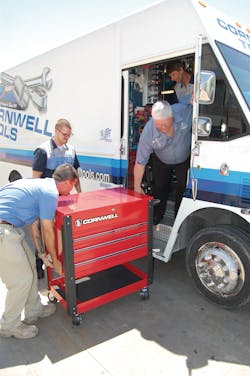Herman Olds was a longtime top Honda technician before he finally “took the plunge to become a tool man.” The talkative San Antonio-area Cornwell Tools dealer is less than five years in, but looked into selling tools as far back as 1980.
“I had a Mac man that I loved dearly in Texas where I started. Ever since then I’ve always toyed with the idea of becoming a tool man,” Herman said. “I backed out I don’t know how many times.”
He investigated all the flags, but liked Cornwell’s small family-owned model best, and that he would get a geographic territory to cultivate rather than a number count. Since signing on, he’s found that sales and self-ownership work for him.
“I’d rather be an owner of a little business than to be an employee and making good money,” Herman said. “I’d rather make $500 a week with Cornwell than $2,000 a week working for a Honda dealer again. It’s just nicer being an owner,” and having control of the business, he said.
“It’s a people business,” Herman said. “You’ve got to sell yourself. Then the product line will sell itself, no matter what you’re selling.”
“The only reason a tool man’s in business is because of service. If it wasn’t for his service and coming around, everybody would go to Harbor Freight, or Northern, or Sears and buy their tools a whole lot cheaper than from a tool man.”
Herman’s got something figured out about the selling, because he’s repeatedly finished in the top 100 for Cornwell.
From the start, he focused on beating his competitors. To become top in his district would lead to more and better things.
“The number two dog eats pretty good; number one eats even better,” he said.
“I’m trying really hard to be a Top 10 dealer, but I haven’t made it yet,” he said. From his first year, when he started in summer, he cracked the top 100 and landed in the 90s. His first full year selling he finished 11th, the next year he was 13th, followed by 24th in a year he wasn’t able to work for a few months due to illness.
“I considered myself lucky just to make the top 30 last year,” Herman said. “I think I did like $480,000 with being out sick part of last year. The year before, I think I did like $579,000.”
Herman said there was some good that came out of being ill.
“My wife went around and collected for me … and she had an easier manner about it,” he said. “She’d try to work with them, and she turned a lot of them around.” Many of Herman’s problem customers became good customers.
But he did lose some customers that needed tools, since his wife could not drive the truck.
“After I got back, it took about six months to get my people back,” Herman said. “When I went back to work, I taught her how to drive the truck and run the route. Now, if I were to get sick again, she and my son could run the route if they needed to.
“But I hope I don’t get meningitis again.”
Before the illness struck, Herman’s route was already a family business.
“My wife is as much a part of the business as me. She takes care of the books. I don’t spend as much time researching tools, I just write notes and give them to her.
“I pay my youngest son to help stock my truck and wash my truck. … Every night when I come home, he’s bringing the tools out and putting it on the truck.” His son also assembles the tool carts.
“We are a family doing a business together.”
Keep moving
Herman is grateful for the help, because when he’s on the route until 7 each night, he is “hustling the whole day.”
He tries to make contact with every customer every week, and counts more than 800 that he calls on. He said about 400 have active truck accounts at any given time.
“I run a small territory, but I have a lot of stops,” he said. “I just keep plugging away. I work my territory very hard, and I’m always looking to grow more customers; so the cycle never ends.”
Herman guesses his territory has close to 1,000 potential customers, but can’t help the “die-hards” for other brands. “I try not to give up a stop if I possibly can sell anything there.
“I sell service, I don’t sell tools. If you sell service, tools will come. And I think that’s how you beat out your competition. … You won’t see me tote and promote. I’ll bring in the new tools, but that’s about it. Other than that, I just make myself available, take care of my customers, and I figure sales will come.”
Herman hands out sales fliers to everyone at every shop. “Every box gets one, whether they buy from me or not. I walk by everybody, even the guys that don’t talk to me,” and he’s sure to ask how they are doing and if they need anything.
“Then with my active customers, I’ll spend a little extra PR time,” he said. He’ll rotate each week which customer groups get the little extra time each day “so that at the end of the month, I’ve kind of PR’d everybody.”
For Herman, there was a learning curve to the business. He thinks his time as a tech helped him, but that anyone who starts selling tools with a “get-rich quick” mentality will have a much harder time getting established.
“The first six months is the hardest. Then the next six months gets a little better. Next six months, a little better. Then after about two years … you get the business turned around.
“Let’s face it, until then you’re trying to build customers. That’s taking money out of your pocket,” he said. “I doubled the recommended inventory the first year. So I didn’t put money in my pocket, I put it back in my business.
“The good thing about this business is everything’s relative to how much you sell and how much you buy. If I sell $200 in one day, and collect $500, I’ve managed to do enough to cover my truck. … You break it down, daily if you need to.” In covering the truck for the day, Herman refers to payment, fuel, maintenance, insurance, etc.
“There are some days you’d like to collect more than you put on the street. Then there’s times where you’ll sell $3,000 in a day and collect $1,200. Then another $1,800 has got to come from somewhere.”
Buy in bulk
More than selling and collecting, Herman said buying smart is essential.
When the Cornwell annual tool fair and rally was in his hometown this year, Herman bought as many on-site samples from booths at higher discounts as he could.
Buying in bulk always helps, he said, especially since the tool fair won’t be in your town every year (or even any year for most distributors). Being in the habit of buying in multiples keeps you ready to take advantage of limited specials and discounts, he said.
“If I buy one tool cart, it costs me about $486; if I partner with another distributor and buy 10 to split, we can get them close to $300 apiece.”
In adding that extra profit into more items, it becomes easier to pair some better-selling higher mark-up tools into deals with stale products you just want off the truck.
“I used to sell quite a few boxes, but I started looking at it – if a box is on a truck for very long, why keep it? It’s just sitting there getting dusty.” And after you sell it, you get one guy that’s paying you maybe $80 to $100 a week.
“Well, I could take the same dollar amount of carts and put 10 carts on the street, and collect from 10 guys, $50 a week.
“That’s $500 a week versus $80,” he said.
“With the times the way they’ve gotten, that’s the direction I’ve moved … selling a lot of little stuff, with a lot of people.
“Then, hopefully you collect — and I do — quite a bit more than you put out on the street.”
Herman has the stock on his truck split with mechanical tools to one side and body shop product on the other. He would like to add more body shops to his route if he could.
“Body shops buy mechanical and body shop tools,” Herman said. “They lose more tools and they’re more tool hounds than mechanics.”
Beyond body shops, Herman likes selling at dealerships. Some of the bigger dealerships in his area are 2-3 hour stops for him, where he has dozens of customers to see.
“In the beginning, even though I wasn’t doing any [dealership] business, I stuck around so they got to know me. I got to be their friend, then they gave me their business. A lot of times people aren’t buying from you because they owe the other people money. They’re not going to tell you that.
“Go in there and be persistent,” he advised to any dealer that wants to up his dealership calls.
“Americans are trained to buy. They like to buy. Say you’ve gone three or four weeks and the guys aren’t buying. Keep showing up, because all of sudden — boom, boom, boom — they’re buying.”


